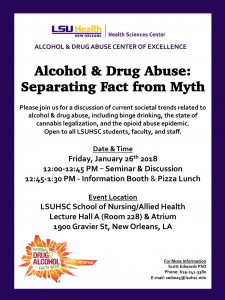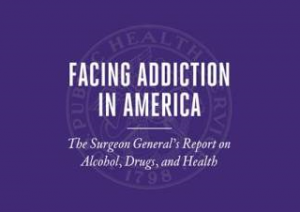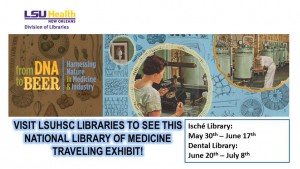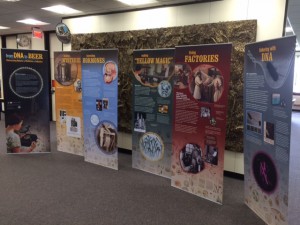This Friday, the LSUHSC Alcohol & Drug Abuse Center of Excellence (ADACE) will be hosting a seminar and discussion here on the downtown campus in association with NIDA’s National Drug & Alcohol Facts Week.
Friday, January 26th
12:00PM-12:45PM: Seminar & Discussion in SON/AH Lecture Hall A (Room 228): Alcohol & Drug Abuse: Separating Fact from Myth
12:45PM-1:30PM: Pizza & Information Booth in Atrium (Outside Lecture Hall A)

Observances, Public Health | Permalink | Comments Off on National Drug & Alcohol Facts Week Event, Friday, January 26, 2018 | Posted Wednesday, January 24, 2018 by Bourgeois, John P.
Dr. Rebekah Gee, secretary of the Louisiana Department of Health, has renewed the standing order for Naloxone, an antidote medication for the reversal of opioid overdose. This action allows laypeople to continue to receive Naloxone without having to get a direct prescription from a doctor.
For more information, see the full health information bulletin.
Public Health | Permalink | Comments Off on LA Dept of Health Renews Standing Order for Naloxone | Posted Monday, January 22, 2018 by Bourgeois, John P.
This month the Isché Library is featuring some of our newest E-books on the New Books Display, located near the 3rd floor elevator. If you would like information on how to access E-books, the circulation staff would be happy to assist you.
These books and many more are available for online access.
Featured E-books from ScienceDirect EBS Collection:
 The ScienceDirect EBS Collection is a group of e-books the LSUHSC Libraries have access to through June 2018. After that time, the most-used books will be added to the Libraries’ permanent collections.
The ScienceDirect EBS Collection is a group of e-books the LSUHSC Libraries have access to through June 2018. After that time, the most-used books will be added to the Libraries’ permanent collections.
Featured E-books from EBSCOhost:
 EBSCOhost E-books may be printed, saved, or emailed one chapter at a time.
EBSCOhost E-books may be printed, saved, or emailed one chapter at a time.
Featured E-books from Ovid: 
Featured E-books from AccessMedicine:
 AccessMedicine E-books may be printed one chapter at a time.
AccessMedicine E-books may be printed one chapter at a time.
These are just some of the latest additions to our E-Book collection. E-Books can be accessed through our catalog and also through the various database links on our webpage.
Tags: AccessMedicine, Digital Collections, ebooks, Ebsco, Education-technology, New books, Ovid, ScienceDirect | Allied Health, Cardiology, Consumer Health, E-Book News, E-Resource News, Family Medicine, Infectious Diseases, Medicine, Neurology, Nursing, Pediatrics, Psychiatry, Public Health, Tips | Permalink | Comments Off on September New Books Display | Posted Saturday, September 9, 2017 by Corder, Amy L.
The Centers for Disease Control and Prevention (CDC) has awarded LSU Health New Orleans School of Public Health $15 million over five years for its cancer education, early detection, comprehensive control and registry programs. The funding will support the Louisiana Breast and Cervical Health and Comprehensive Cancer Control programs, as well as the Louisiana Tumor Registry at LSU Health New Orleans School of Public Health.
Public Health | Permalink | Comments Off on $15 Million Grant to LSUHealthNO to Help Reduce Cancer in Louisiana | Posted Tuesday, August 8, 2017 by Bourgeois, John P.
Dentistry, Public Health | Permalink | Comments Off on A Lesson in How NOT to Practice Dentistry or Social Media | Posted Thursday, May 18, 2017 by Lucas, Wesley B.
The CDC has created a challenge that will optimize the usage of The Tracking Network. The CDC explains, “[t]he goal of this Challenge is to receive innovative uses for the Tracking Network data from CDC’s application programming interface to explore the connections between the environment and health”.
The submission period is open now and closes June 23, 2017.
The time line for the rest of the challenge is:
- Evaluation Period: June 27- July 29
- Notify Screening Participants: July 20
- Final Evaluation Period: August 15-29
- Winners Announcement: By September 1, 2017
The Judges for the contest are
- Jeff Markwell, Senior Firmware Engineer of Fitbit
- Kishore Hari, Director of Bay Area Science Festival
- Grant Pezeshki, Director of Public Portals
- CK Kochukoshy Cheruvettolil, Senior Financial Manager of Bill and Melinda Gates Foundation
- Pat Breysse, PhD, Director of NCEH/ATSDR
Award Prizes:
- 1st place – $20,000
- 2nd place – $7,000
- 3rd place – $3,000
For more information on this challenge and how to enter, please visit the CDC website. http://www.envirohealthchallenge.com
The Isché Library is featuring books about subjects related to upcoming health observances in the Month of May! Information about these health observances as well as the featured books are in the New Books display. The display is located near the 3rd floor elevator. Subjects include Sports Medicine, Emergency Medicine, Dermatology, Environmental Public Health, and Immunology.
These books and many more are available for checkout and/or online access. If you have questions about checking out a book, do not hesitate to ask a library staff member.
May 26 is Heat Safety Awareness Day.

May is National Physical Fitness and Sports Month.
- Clinical Sports Medicine, 3rd ed., by Peter Brukner, Karim Khan.
- Motivating People to be Physically Active, by Bess H.Marcus, LeighAnn H. Forsyth.
- Physique, Fitness, and Performance, 2nd ed., by Thomas Battinelli.
- A Lifelong Guide to Wellness and Prevention, by Louisiana State University Health Sciences Center, Department of Occupational Therapy, School of Allied Health Professions. Also available in E-book format!
- ACSM’s Guidelines for Exercise Testing and Prescription, 8th ed., by American College of Sports Medicine; senior editor, Walter R. Thompson; associate editors, Neil F. Gordon, Linda S. Pescatello.
May is Melanoma/Skin Cancer Detection and Prevention Month ®.
May 22 – 28 is Healthy and Safe Swimming Week.
May is National Asthma and Allergy Awareness Month.

- Global Surveillance, Prevention, and Control of Chronic Respiratory Diseases : A Comprehensive Approach, edited by Jean Bousquet and Nikolai Khaltaev; core contributors were Alvaro A. Cruz … et al. Also available in E-book format!
- Clinical Manifestations and Assessment of Respiratory Disease, 6th ed., by Terry Des Jardins, George G. Burton ; medical illustrations by Timothy H. Phelps.
- Bronchial Asthma : A Guide for Practical Understanding and Treatment, 5th ed., edited by M. Eric Gershwin, Timothy E. Albertson.
- Allergy, 3rd ed., edited by Stephen T. Holgate, Martin K. Church, Lawrence M. Lichtenstein.
- Atlas of Allergic Diseases, edited by Phillip L. Lieberman, Michael S. Blaiss; with 39 contributors.
Tags: New books | Allied Health, Books, Emergency Medicine, Family Medicine, Library News, Medicine, Microbiology, Observances, Occupational therapy, Otorhinolaryngology, Pathology, Pediatrics, Physical Therapy, Physician Assistant, Public Health, Toxicology | Permalink | Comments Off on May Health Observances Display | Posted Monday, April 24, 2017 by Corder, Amy L.
Researchers have been working on an experimental blood test that could point out autism in children. So far, the test is 98 percent accurate in children ages 3 to 10 in diagnosing if they have autism.
“The test was able to predict autism, regardless of where on the spectrum an individual was,” according to study co-author Juergen Hahn in the MedlinePlus article. The test was also able to indicate the severity of the autism-related condition with good accuracy.
This new test is a stark contrast to the current approach of diagnosing autism, which entails a consensus from a group of medical professionals. The blood test, on the other hand, looks for key metabolism markers in the child.
The study was small, with less than 200 participants, so more research is planned to follow-up on the claims.
To read more about the study, please visit “Could a Blood Test Spot Autism in Childhood?”
Reblogged from Blogadillo on March 23, 2017 from the NNLM/SCR. Like them on Facebook and like us on Twitter.
Our friends with the Environmental Public Health Tracking (EPHT) Program would like you to know that FEMA is hosting a Disaster Resource Fair this Saturday, April 8, 2017, at the New Orleans East Hospital (NOEH) located at 5620 Read Blvd from 9am-3pm. This event is for those residents affected by the 2016 Flood and the 2017 tornado.
The EPHT Program is part of the the Louisiana Department of Health (LDH) Section of Epidemiology & Toxicology Resources (SEET). EPHT operates and maintains Louisiana’s Health Data Portal where users can view and analyze environmental health data. Louisiana is part of the Center for Disease Control and Prevention’s (CDC) National Environmental Public Health Tracking Network.
LSU Health New Orleans School of Medicine will present LGBT
Health Care Symposium:
Insight on Current Affairs and the Future of LGBT Health Care on Monday, April 10, 2017, from 6:30 – 8:00 p.m. on campus at the Medical Education Building, 1901 Perdido Street, in Lecture Room A (first floor). Parking will be available in Student Lot #2, located on Perdido Street between South Prieur and Bolivar streets. The event is
free and
open to the public.
The event is sponsored by ETHIKOS and LGBT+Allies Organization for the Cultural Understanding in the Health Sciences (LOCUS), the ethics and LGBT student interest groups at LSU Health New Orleans School of Medicine.
The Louisiana Department of Health has an interactive map that allows state “health, environmental, population and exposure information and data” to be viewed and compared in a single place.
New fields and more information will be added in the near future, updating the tool continually.
http://healthdata.dhh.la.gov/
Public Health | Permalink | Comments Off on Louisiana’s Health Data Portal | Posted Wednesday, March 22, 2017 by Bourgeois, John P.

On November 29th, the US Surgeon General‘s Office released the office’s first ever comprehensive report on addiction. The full report, Facing Addiction in America: the Surgeon General’s Report on Alcohol, Drugs, and Health, is over 400 pages long. There is an Executive Summary which is 36 pages in length.
The Centers for Disease Control has launched a new resource, VetoViolence. This website offers “free, online, interactive, and engaging violence prevention tools, trainings, and resources based on the best available evidence and research. The tools, trainings, and resources provide practical knowledge and skills to assist and enhance the work of violence prevention practitioners.” The aim of the website is to create safer communities for everyone.
 The LSU Health New Orleans Stanley S. Scott Cancer Center will host a Cancer Moonshot Summit on June 29 from noon to 4pm at the Louisiana Cancer Research Center, 1700 Tulane Ave. Augusto Ochoa, MD, director of the Cancer Center is hosting the summit. He is the only Louisiana expert on the Blue Ribbon Panel and one of 28 nationwide.
The LSU Health New Orleans Stanley S. Scott Cancer Center will host a Cancer Moonshot Summit on June 29 from noon to 4pm at the Louisiana Cancer Research Center, 1700 Tulane Ave. Augusto Ochoa, MD, director of the Cancer Center is hosting the summit. He is the only Louisiana expert on the Blue Ribbon Panel and one of 28 nationwide.
This meeting will be open to the public and is free. It will cover clinical trials, treatment, philanthropy and advocacy. Registration is preferred: www.surveymonkey.com/r/L87SPTV.
“The White House Cancer Moonshot Task Force’s mission is to double the rate of progress in cancer research and treatment, striving to accelerate what could be achieved in ten years in just five. The goals of the Cancer Moonshot cannot be achieved by one person, one organization, one discipline, or even one collective approach. Rather, solving the complexities of cancer requires the formation of new alliances to defy the bounds of innovation and accelerate the prevention, diagnosis, treatment, and – ultimately – the curing of cancer.” Summits will be happening nationwide on June 29th.

The National Library of Medicine’s traveling exhibit “From DNA to Beer: Harnessing Nature in Medicine and Industry” is now at the LSU School of Dentistry Library! Come explore the history of biotechnology, and peruse our selection of related books and articles. The Dental Library is located on the third floor of the Administration Building, and the exhibit will be there from June 20th-July 8th.
This exhibition was developed and produced by the National Library of Medicine, National Institutes of Health and the Smithsonian’s National Museum of American History. Additional information about this exhibit can be found online: https://www.nlm.nih.gov/hmd/about/exhibition/fromdnatobeer.html.

NLM display at Dental Library

Supplemental Materials Display
MICROBES—tiny organisms too small to be seen with the naked eye—have altered human history. Life forms such as bacteria, yeasts, and molds can cause sickness or restore health, and help produce foods and beverages.
Scientists, in partnership with industry, have developed techniques to harness the powers of these microbes. In recent years, headline-grabbing technologies have used genetically modified bacteria to manufacture new medicines.
A glimpse into the past reveals a history of human enterprise that has adapted these tiny organisms for health and profit. This exhibition explores some of the processes, problems, and potential inherent in technologies that use life.
Campus News, Dental Library, E-Resource News, Library Events, Library News, Medicine, Microbiology, Public Health | Permalink | Comments Off on NLM exhibit “From DNA to Beer” now at Dental Library! | Posted Monday, June 20, 2016 by Lucas, Wesley B.


 myLSUHSC
myLSUHSC EBSCOhost E-books may be printed, saved, or emailed one chapter at a time.
EBSCOhost E-books may be printed, saved, or emailed one chapter at a time.
 AccessMedicine E-books may be printed one chapter at a time.
AccessMedicine E-books may be printed one chapter at a time.





